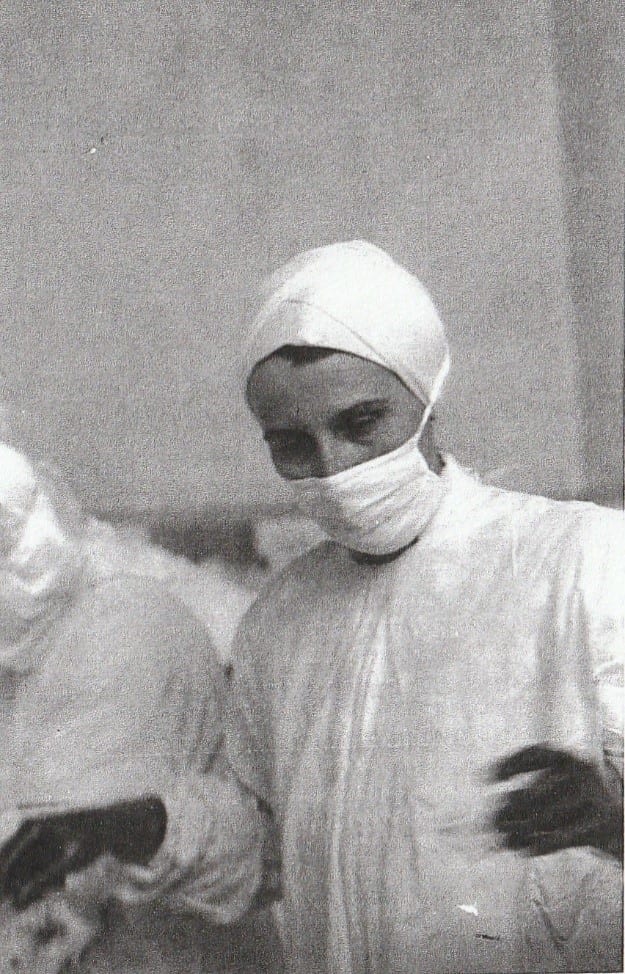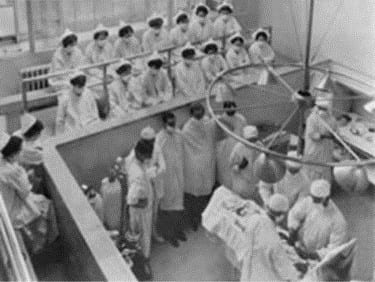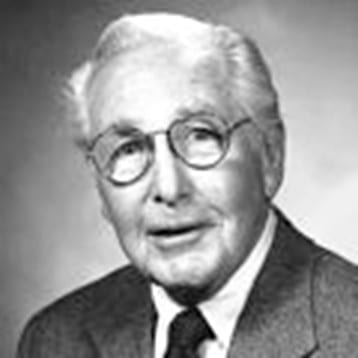Frederic Grannis
Duarte, California, United States
 |
| Doris Unland RN “scrubbed in” OR 10. |
Doris Unland was an extraordinary American surgical nurse who worked for forty-seven years at St. Mary’s Hospital in Rochester, Minnesota. She may have participated in more major surgical operations than any other person—physician or nurse—in history.
Born on December 19, 1910, she traveled in 1932 to Rochester, Minnesota, to attend Saint Mary’s Hospital School of Nursing. After graduation, she stayed on at St. Mary’s, first as a surgical nurse and then as head nurse for several prominent Mayo Clinic surgeons.
The responsibilities of surgical nurses “went far beyond assisting with operation. They sewed caps and masks, folded and sterilized linens, washed, patched, and sterilized rubber gloves. After washing, boiling, and rinsing gauze packs dipped in saline solution, they hung them out to dry on the Joseph (Surgical) Building balconies.”1
Sister Paula Leopold, who called Unland a “mentor and friend,” served with her as a young surgical nurse during World War II and recalled days when they worked from 7 AM to 11 PM:
“The next day we began again at 7 and remained until all surgeries were completed, perhaps twelve or 14 hrs. at a stretch. We were young, help was very short, and we did what we were asked to do.”2
During World War II, many Mayo surgeons were drafted into the military and served during General MacArthur’s New Guinea campaign. “The period of WWII was probably the busiest time surgically we’ve ever had,” Unland recalled. “So many physicians were called into the service that those of us who were left worked harder than ever. It was not unusual for one surgeon to do 13 to 15 procedures a day, sometimes as many as 20, and to work six days a week.”
During World War II, Dr. O.T. “Jim” Claggett assumed a large part of the workload.3 “I believe my longest surgical list in one day was 23 major operations. . . . Lists of 15 to 20 operations daily were almost routine.”4 In his autobiography, Claggett expressed gratitude for the assistance he received from Doris Unland during these arduous years.5
Ms. Unland also assumed a teaching role and was honored in 1946 for her service with the U.S. Nurse Corps Instructors “in recognition of the wartime contributions of instructors of the members of the U.S. Cadet Nurse Corps,” who “prepared the largest classes of student nurses in history for military and essential civilian nursing.” These nurses included many young Japanese-American women who had been interned in relocation camps such as that at Manzanar in California.
 |
| St. Mary’s operating room Joseph Building circa 1940. |
Pat Ringer Kennedy described the life of a scrub nurse at St. Mary’s:
“I was assigned for intensive work with Doris Unland in OR 10. I was fortunate, as she had been there a long time and was a walking mine of information. Fifty-five years ago, there were twenty-five operating rooms, which were two floors in height. This allowed for the viewing gallery, where visiting physicians sat in rows, leaned over the rail and observed the procedures. We worked long hours and continued to work until our scheduled list was finished, then we cleaned our OR rooms. We scrubbed down the walls, floor, and sinks, and then we organized our instruments and sutures for the coming day before we called it quits. . . . Always the goal was excellent patient care.”7
Kathy Polikowsky trained as a scrub nurse under Doris Unland and worked with her for fifteen years. She recalls that “Doris was very ‘old school’ in her approach to work, had a very strong work ethic, and demanded the same of others if you were to get her acceptance.” (personal communication, 1/27/2018)
Barbara Prokasky remembers that “OR 10 was not just an operating room, it was Doris Unland’s room. I can’t imagine a more dedicated nurse.” (personal communication, 9/11/2017)
A measure of the excellence of Unland’s surgical nursing is reflected in the list of distinguished American surgeons who chose her to manage their operating rooms. Pairs of Mayo Clinic surgeons performed their elective surgical procedures on alternating “blue and orange” days in two adjoining operating suites. During the period from 1936 and extending into the 1960s, Ms. Unland staffed the operating rooms of Drs. Waltman Walters and Charles Mayo.
 |
| Martin Adson M.D. |
Walters trained at Mayo starting in 1920, serving as first assistant to both William and Charles Mayo, and married Phoebe, the daughter of Dr. Will Mayo. He worked as a staff surgeon for thirty-six years.8 He was editor of Archives of Surgery and Lewis-Walters Practice of Surgery and served as a rear admiral in the U.S. Navy.9
“Charley” Mayo (1889-1968) was the son of Charles H. Mayo, and among many accomplishments chaired the Mayo Foundation, served on the board of regents of the University of Minnesota, and as president of the American Association of the United Nations.10, 11, 12
From the 1960s through the 1980s, Ms. Unland worked with Drs. Donald McIlrath and Martin Adson. McIlrath served as chairman of the department of surgery and as director of the general surgery residency and assisted on the cholecystectomy of President Lyndon Baines Johnson.13, 14 He recalls that Ms. Unland was “intelligent, strong and technically unsurpassed” and praised her extraordinary sense of duty. He recalled late nights when she was off call, but would come in to help when she saw the lights on in the fifth-floor operating room from her home nearby. (personal communication, 6/1/2017)
Martin Adson (1924-2011) completed his training at Mayo, served as a consultant in general surgery from 1957 to 1988, James C. Masson Professor of Surgery at the Mayo Medical School, and president of the Mayo Clinic staff. He held office in several surgical societies and published more than one hundred surgical articles. Following retirement, he wrote extensively on medical ethics until his death at age eighty-six in 2011.
Dr. Anthony Edis remembers Ms. Unland fondly:
“Doris was my principal OR scrub nurse during my 6-year tenure as a Mayo Clinic surgeon, but also a lot more. She was my moral support, confidante, colleague, trusted family friend. We had a special bond and our association was characterized by mutual respect and professionalism.”
The author worked in Ms. Unland’s OR as a surgical intern, resident, and chief resident between 1969-1978. She was an imposing woman, tall, slender and austere, and intimidating for a callow surgeon-in-training. She exhibited a work ethic and professionalism that was extraordinary by any standard. Although in her early sixties at that time, she never took a break during an operation, no matter how long and difficult, always worked until the surgical list for the day was completed, and continued to, indeed insisted upon, taking weekend and night calls. On many weekend days “off” she could be found in the St. Mary’s visitors’ coffee shop, dressed in the pink uniform of a hospital volunteer.
 |
| Doris Unland RN in retirement, June 1991. |
Unland worked as a surgical nurse for forty-seven years before retiring in 1983 at age seventy-three. The author has been unable to access records that would allow quantification of how many surgical operations she staffed during her long career but can speculate confidently that she may have scrubbed on more cases than any other surgeon or nurse in history.
Doris Unland died on December 1, 1991, at age eighty-one in St. Mary’s Hospital.
Dr. Martin Adson gave a moving eulogy during her funeral service on Dec 3, 1991 at St. John’s Catholic Church in Rochester, Minnesota that provides exceptional testimony to the close professional and personal relationship that can exist between a surgeon and surgical nurse:
“Doris and I worked together for 25 years. She has been a very big part of my life. I spent more time with her than any other human being. We shared the daily meaning, astonishment and wonder involved in healing—along with the uncertainty and pain.”16
He also recalled that:
“She never left my side during the scheduled working day, even when it extended in an unscheduled way into the late evening and in the early years so often into the night.”
The operating room number was not just his.
“It is more hers than mine . . . it is really the patient’s operating room.”
Adson also credited Unland with deepening his understanding of medical ethics. He related that during her last two years, he visited her in her home, hospital, and nursing home, and observed that “despite her terrible disease, she was able to transcend. In her great strength and in her great capacity to see things the way they should be seen, she stayed whole.” He related:
“One day after visiting her I returned home and my wife Pat said, ‘Why do you look so good?’ Then it occurred to me that I had gone out to help Doris and instead that she had helped me. I realized how much it was that she was so beautiful to me.”
He continued in a highly personal tribute:
“It was the same voice that I had heard when I was a very young surgeon, pushed by circumstances to do new things. When things got most difficult, I could feel Doris’s shoulder pressed into mine and, with her head down, I heard her whisper in my ear. ‘You can do it’ . . . Hers was the voice of responsibility, commitment and constancy . . . Hers was the voice of strength.”
Dedication:
This paper is dedicated in gratitude to the surgical nurses I had the great privilege to work with between 1969-2015. In addition to Doris Unland, they include Ann Irvin, Elizabeth Semb, Rosa Edwards, Milly Tyson, Paul Liming, Gwendolyn Jones, and Sally O’Rourke. The author apologizes for any omissions and attributes them to the exigencies of advancing age.
References:
- Dacy M. Exhibit Honors Franciscan-Mayo Collaboration https://www.rochesterfranciscan.org/images/PDFs/Interchange/Summer2012Interchange.pdf Accessed June 20, 2018
- Whelan E. The Sisters’ Story: Saint Marys Hospital – Mayo Clinic 1889 to 1939 Part Two. Rochester, MN: Mayo Foundation for Medical Education and Research; 2007.
- World War II Medical Research Center website. https://www.med-dept.com/articles/ww2-military-hospitals-pacific-theater-of-operations/ Accessed June 20, 2018.
- Simons Wentzel V. Sincere et Constanter 1906-1970: The Story of Saint Marys School of Nursing. Rochester, MN: Mayo Foundation for Medical Education and Research; 2006. http://mccms.cws.net/content/history.mayoclinic.org/files/MC_Values_Book_Chap6A.pdf Accessed 9/3/18.
- Clagett OT. Reflections of O.T. “Jim” Clagett. [Publisher not identified] Rochester, MN: O.T. Clagett; 1979.
- Sisters of Saint Francis. News – April 2018 website. https://www.rochesterfranciscan.org/whats-new/news-archives/216-news-april-2018.html Accessed July 10, 2018.
- Kennedy PR. OR Nursing in the 50’S AND 60’s Alumni News Saint Mary’s School of Nursing Summer 2014.
- Waltman W. Forty years of surgery at the Mayo Clinic: an autobiographic essay. Perspectives in Biology and Medicine. 1963;7:3-38.
- Beahrs O. Surgical Reminiscence. Dr Waltman Walters. Arch Surg. 2001;136(4):478.
- Lyndon B. Johnson: “Statement by the President on the Death of Dr. Charles W. Mayo” July 29, 1968. Online by Gerhard Peters and John T. Woolley, The American Presidency Project. http://www.presidency.ucsb.edu/ws/?pid=29044.
- Stewart E. Operating room 10 and Dr. Charles William Mayo. our thoughts. Available at https://mayoclinichealthsystem.org/hometown-health/our-thoughts/operating-room-10-and-dr-charles-william-mayo. Accessed July 10, 2018.
- Eckman, J, Berkson J. Charles William Mayo, M.D., 1898–1968: as we remember him. J Lancet. 1968;88(12):319–21.
- History of Surgery at the Mayo Clinic website. https://www.mayo.edu/mayo-clinic-school-of-graduate-medical-education/residencies-fellowships/surgery-specialties/surgery-general-categorical-residency-minnesota/history-of-surgery-at-mayo-clinic Accessed July 10, 2018.
- Pappas TN, Mulvihill MS. The President’s gallbladder: A historical account of the cholecystectomy of Lyndon Baines Johnson. Surgery. 2010;147(1):160-166.
- Obituary, Dr. Martin Adson (2011, February 20). Star Tribune. Rochester MN. http://www.startribune.com/obituaries/detail/12950320/. Accessed July 6, 201
- Adson MA. Eulogy for Doris Unland, Dec 3, 1991, St. John’s Catholic Church in Rochester, Minnesota. From the Archives of the W. Bruce Fye History of Medicine Library. by permission of Mayo Foundation for Medical Education and Research
Image Credit
- All photographs are by permission of Mayo Foundation for Medical Education and Research.
Acknowledgment:
The following individuals provided kind assistance in the search for historical and biographical information.
- Matt Dacy, Director of Mayo Clinic Heritage Hall; Renee Ziemer, Coordinator, W. Bruce Fye Center for the History of Medicine & Mayo Clinic Historical Suite; Hilary J. Lane, Coordinator, W. Bruce Fye History of Medicine Library; Judy Anderson, Director, Mayo Clinic Alumni Association.; Murtice Robinson Sherek, President, Saint Marys School of Nursing Alumni Association
The following individuals provided direct information in interviews and correspondence.
- Sister Lauren Weinandt, official keeper of the St. Mary’s Hospital archives (has worked at Saint Marys for 58 years, longer than any other employee); Sister Merici Maher; Sister Antoine Murphy ’41; Sister Elizabeth Gillis; Barbara Prokasky RN; Donald C. McIlrath MD; Roger Dozois MD; Arthur Silver MD; Anthony Edis MD
FREDERIC W. GRANNIS, MD, is a retired thoracic surgeon with continuing research interests in disease caused by tobacco products, lung cancer screening, and the history of medicine and surgery.
Highlighted in Frontispiece Volume 13, Issue 2– Spring 2021 and Highlighted Vignette Volume 14, Issue 1 – Winter 2022

Leave a Reply